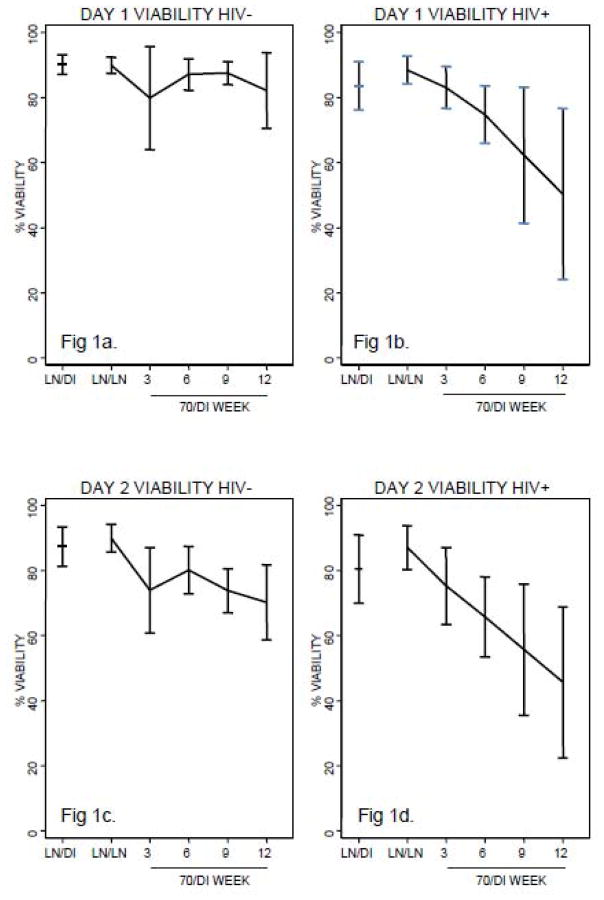Figure 1.
Viability and viable recovery of cryopreserved PBMC from HIV-infected and uninfected subjects according to shipment and storage conditions. Data derived from 12 HIV+ (HIV-infected) and 12 HIV− (HIV-uninfected) subjects are presented as mean and 95% CI of the viability and viable recovery on Day 1= day of thawing and on Day 2= after overnight incubation, when functional assays were set up. Cells were cryopreserved at a central laboratory and shipped to the testing laboratories in the conditions indicated on each graph: LN/DI=stored in liquid nitrogen and shipped on dry ice; LN/LN=stored and shipped in liquid nitrogen; 70/DIstored at −70°C and shipped on dry ice. 3, 6, 9, 12 indicate the numbers of weeks of storage at −70°C before shipment. The testing laboratories thawed and assayed samples from each subject in the same run. Figures 1a and 1c show that the viability of samples from HIV-uninfected individuals did not differ among LN/LN, LN/DI and 70/DI 3 samples on Day 1. On Day 2, there were no significant differences in LN/LN and LN/DI sample viability, but 70/DI 3 samples had significantly lower viability than LN/LN or LN/DI samples (p of 0.03 and 0.04, respectively). The Day 2 viability of 70/DI samples significantly decreased with the time of storage at −70°C (p=0.01), but the Day 1 did not (p=0.56). Figures 1b and 1d show that both Day 1 and Day 2 viability of cells from HIV-infected individuals was significantly higher in LN/LN compared with 70/DI 3 samples (p of 0.05 and 0.04, respectively). Viability of LN/DI samples was similar with that of LN/LN samples on Day 1, but lower on Day 2 (p of 0.1 and 0.03, respectively). No differences were observed in LN/DI and 70/DI 3 samples. There were sharp linear decreases of viability over time of storage at −70°C on Day 1 and Day 2 (p of 0.01 and 0.004, respectively). Figures 1e and 1g show that the viable recovery of samples from HIV-uninfected individuals did not differ among LN/LN, LN/DI and 70/DI 3 samples on Day 1. On Day 2, there were no significant differences in LN/LN and LN/DI sample viable recovery, but 70/DI 3 samples had significantly lower viable recovery than LN/LN or LN/DI samples (p of 0.02 and 0.05, respectively). The Day 2 viable recovery of 70/DI samples significantly decreased with the time of storage at −70°C (p =0.007), but the Day 1 did not (p=0.60). Figures 1f and 1h show that both Day 1 and Day 2 viable recovery of cells from HIV-infected individuals was significantly higher in LN/LN compared with 70/DI 3 samples (p of <0.01 and 0.02, respectively). Viable recovery of LN/DI samples was lower than that of LN/LN samples on Day 1, but similar on Day 2 (p of 0.01 and 0.09, respectively). No differences were observed in LN/DI and 70/DI 3 samples. There were sharp linear decreases of viable recovery over time of storage at −70°C on Day 1 and Day 2 (p of 0.0098 and 0.0078, respectively).


